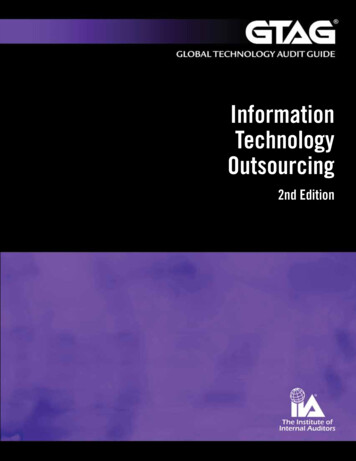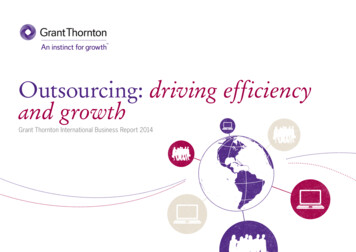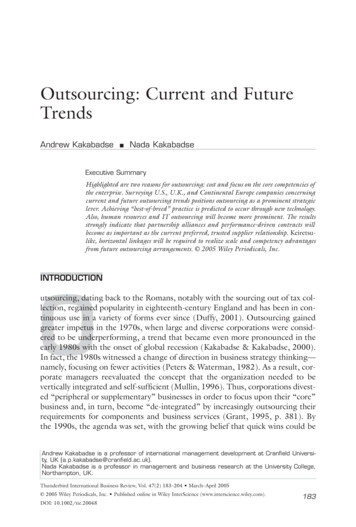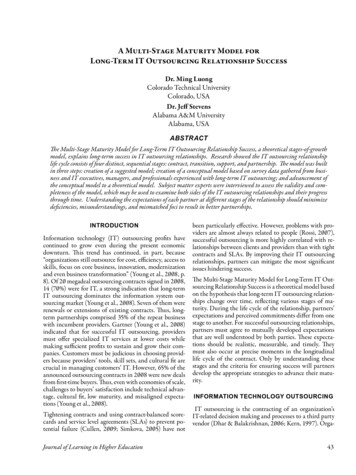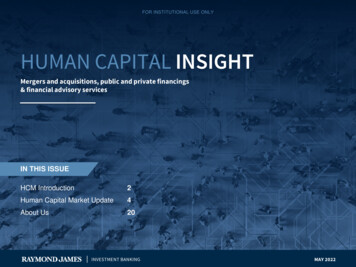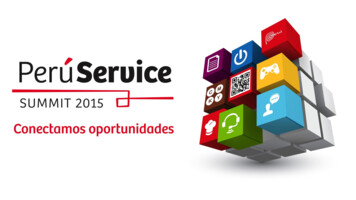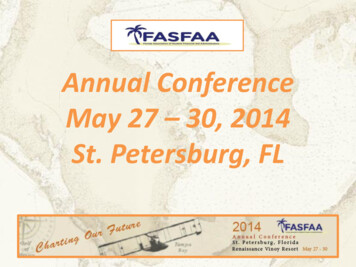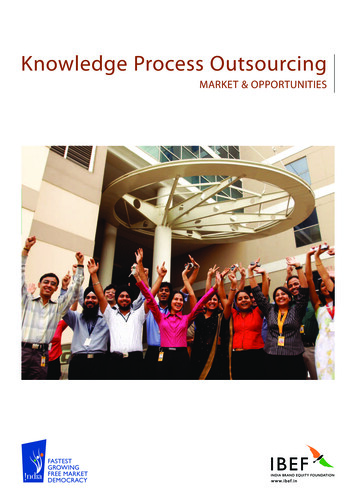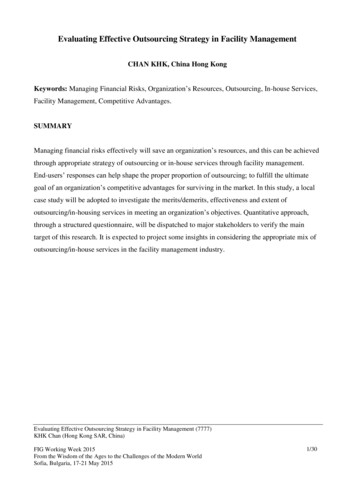
Transcription
Evaluating Effective Outsourcing Strategy in Facility ManagementCHAN KHK, China Hong KongKeywords: Managing Financial Risks, Organization’s Resources, Outsourcing, In-house Services,Facility Management, Competitive Advantages.SUMMARYManaging financial risks effectively will save an organization’s resources, and this can be achievedthrough appropriate strategy of outsourcing or in-house services through facility management.End-users’ responses can help shape the proper proportion of outsourcing; to fulfill the ultimategoal of an organization’s competitive advantages for surviving in the market. In this study, a localcase study will be adopted to investigate the merits/demerits, effectiveness and extent ofoutsourcing/in-housing services in meeting an organization’s objectives. Quantitative approach,through a structured questionnaire, will be dispatched to major stakeholders to verify the maintarget of this research. It is expected to project some insights in considering the appropriate mix ofoutsourcing/in-house services in the facility management industry.Evaluating Effective Outsourcing Strategy in Facility Management (7777)KHK Chan (Hong Kong SAR, China)FIG Working Week 2015From the Wisdom of the Ages to the Challenges of the Modern WorldSofia, Bulgaria, 17-21 May 20151/30
Evaluating Effective Outsourcing Strategy in Facility ManagementCHAN KHK, China Hong Kong1. BACKGROUNDWhat are the options and which should be progressed in an organization, and what are the pros andcons? Can the existing business processes be improved or any additional controls required?Considering in-house development for cutting edge can be spoken solutions or outsourcingmanagement package solution for more standardized requirements.1.1 Outsourcing and In-House ManagementOutsourcing is defined as the procurement of products or services from sources that are external tothe organization. As shown in Figure 1, today’s modern organization has to balance the potentialbenefits of outsourcing with its potential costs in order to determine the proportion of outsourcingto in-house that will best achieve the organization’s objectives. Inappropriate proportion ofoutsourcing to in-house can result in business failures and not fulfilling the customers’ satisfactions.Evaluating Effective Outsourcing Strategy in Facility Management (7777)KHK Chan (Hong Kong SAR, China)FIG Working Week 2015From the Wisdom of the Ages to the Challenges of the Modern WorldSofia, Bulgaria, 17-21 May 20152/30
Possible costs of outsourcing:Possible costs of in-house:-Unable to compete with firmswith outsourcing-Increase labour costs relative tooutsourcing competition- Loss of control of activity- Reporting/accounting problems- Employee resentment/bad moraleOutsourcingIn-housePossible benefits of in-house:-Control of production activity-Loyal workforcePossible benefits of outsourcing:-Reduced costs of activities-Reduced risk in operations-Greater diversification ofactivitiesFigure 1. Balancing Outsourcing and In-house Benefits & Costs1.2 Outsourcing & In-House Labour MarketThe internal labour market, governed by administrative rules, is to be distinguished from theexternal labor market of conventional economic theory where pricing, allocating and trainingdecisions are controlled directly by economic variables. Consequently these jobs are shielded fromthe direct influence of competitive forces in the external market (Schniederjans, 2005).Evaluating Effective Outsourcing Strategy in Facility Management (7777)KHK Chan (Hong Kong SAR, China)FIG Working Week 2015From the Wisdom of the Ages to the Challenges of the Modern WorldSofia, Bulgaria, 17-21 May 20153/30
The external labor market (outsourcing), on the other hand, can take on many forms such asout-tasking, co-sourcing, contracting, partnering and alliancing, and generally is characterized by: individual service providers along a company’s value chain; contingent and ‘portfolio’ workers assigned on a project-by-project basis; and spot transactions and contracted procurement.1.3 Values from In-House Facility ManagementWhen facility management (FM) is performed in-house the following added value wouldevolve.Reduced costsThrough less management effort and less activity required to fulfill FM activities. That is, aself-sufficient system requiring little managerial monitoring due to job specific nature (Mclvor,2005) equipment idiosyncrasies – due to incompletely standardized yet common equipment theindividual attributes of which are ‘learned’ by experience only; process nature – due to worker adaptations during production and individual fashioningand styles; informal team accommodations – due to specific team changes, which are only known bythe team from mutual adaptations; and communication nature – which are information codes and channels only of value withinthe specific firm and which the employees are able to own for best fit purposes. Forexample, an in-house facilities manager is able to formulate and manage a comprehensivelift maintenance contract able to deliver great value to the organization due to thein-depth knowledge of each lift concerned – learned over time.Increase in flexibility&control to fulfill FM requirementsThere is management discretion and ability to adjust labor input; to match demand whenrequired. For example, senior management decides to relocate a division to another building. Across-functional project team is set up from within other parts of the organization for theEvaluating Effective Outsourcing Strategy in Facility Management (7777)KHK Chan (Hong Kong SAR, China)FIG Working Week 2015From the Wisdom of the Ages to the Challenges of the Modern WorldSofia, Bulgaria, 17-21 May 20154/30
duration of the project – utilizing existing resources temporarily redeployed to suit the businessrequirements (Corbett, 2004).Reduction in opportunismThere is elimination of the potential for competing forces to artificially expand the cost offacility management, i.e. resistant to market forces to some degree. For example, large facilitymanagement outsource companies charging a higher unit rate for facility management than isnecessary (because it is what the market is willing to pay), where the actual costs associated aremuch lower when performed in-house (Corbett, 2004).Costs for In-House FMThe costs associated with utilizing in-house procurement of FM are that there is an eventualtendency for teams to become large bureaucratic structures. According to Peter Drucker, ahighly renowned management author, in an article in the Wall Street Journal (1990) states thatin-house support services (such as FM) within organizations have become defacto monopolieswith little productivity incentives due to boredom. When required to improve productivity,more staff are then likely to be employed thus perpetuating the problem. That is, too manyresources and too much wastage equal reduced efficiency. For example, in-house trades teamsbecoming significantly less productive than external subcontractors, requiring twice the numberof labor inputs to achieve the same work output (Schniederjans, 2005).1.4 Values from Outsourcing FMValues/savings from in-house to outsourceThis is also achieved through the provider being a specialist in the area of FM. For example, aspecialist facility management company is coming to the end of a large contract with a client andhas underutilized resources (people). It also has two other very large clients that it services. It istherefore able to supply this underutilized resource at a very competitive price to any potentialclient organization (Schniederjans, 2005).Evaluating Effective Outsourcing Strategy in Facility Management (7777)KHK Chan (Hong Kong SAR, China)FIG Working Week 2015From the Wisdom of the Ages to the Challenges of the Modern WorldSofia, Bulgaria, 17-21 May 20155/30
Increased competitive advantage efficienciesBy giving over control and ownership of the FM activities to someone else, the organization isable to focus management resources onto core activities in order to improve efficiencies andconcentrate on competition advantages. For example, a large utilities company outsources its FM.It then re-invests management time (previously used on FM) into essential research anddevelopment projects (Corbett, 2004).Increased flexibilityBy eliminating fixed overheads, bureaucracy and physical plant ownership. For example,financial institutions outsource FM Department and embarks on a sale and leaseback program ofits owned/occupied premises. At the same time it decentralizes its banking operations, flatteningits company structure (Corbett, 2004).1.5 Costs in Outsourcing FMLoss of controlWithout doubt, handing over control and ownership to an external supplier means you hand overa climate to create a monopoly situation. The client organization would more than likely divestthis transfer of ownership and control to multiple providers to avoid this monopoly. This wouldcause an increase in management time and effort (monitoring multiple contracts) (Corbett, 2004).Decreased flexibilityThere are costs associated with decommissioning plant and equipment. The cost to theoutsourcing provider to take over the facility management is high due to the large size of the site.Payback is going to be long-term – thus a long-term contract is negotiated. The contract termcould reduce the client’s ability to scale back facility management activities to suit production(Corbett, 2004).Decreased staffing quality & availabilityThe skills required of a ‘portfolio’ worker are the ability to be flexible, motivated, articulate andavailable, in order to perform in a multiple workplace environment. The skills required of theEvaluating Effective Outsourcing Strategy in Facility Management (7777)KHK Chan (Hong Kong SAR, China)FIG Working Week 2015From the Wisdom of the Ages to the Challenges of the Modern WorldSofia, Bulgaria, 17-21 May 20156/30
in-house employee are organizational specific skill sets or job specific nature learned over time.As such there will be high learning curves for transitioning staff– requiring management focus.This leads to a high demand for relevant people almost from day one of the outsourcing contract.As outsourcing became more and more well accepted, facility managers seem to feel that itlessen the need for proper organization. Outsourcing is essentially a staffing issue. Whether thepositions are filled by in-house staff, consultants or contract staff, it is important to get theorganization correct to meet customer needs (Schniederjans, 2005)Decreased quality – increased costsThe supplier's need for profit growth may force it to try to move components of the processoutside the scope of the services so that it can then charge extra for them and satisfy its profitneeds. This will mean focused monitoring and contract management by the client organizationwill be necessary. This monitoring will lead to an increase in costs for the client organization(transaction costs) (Schniederjans, 2005).Figure 2 Value & cost relationshipEvaluating Effective Outsourcing Strategy in Facility Management (7777)KHK Chan (Hong Kong SAR, China)FIG Working Week 2015From the Wisdom of the Ages to the Challenges of the Modern WorldSofia, Bulgaria, 17-21 May 20157/30
2.LITERATURE REVIEWIn order to make an effective decision, one of the first steps is to identify the needs of theorganization and understand why outsourcing may or may not be appropriate. The followingreasons to adopt external resources may apply: To have access to technology, skills, and knowledge not internally available To improve business processes and enable organizational change To provide needed short-term services without adding to ongoing operational costs To focus internal resources on core strategic plans and projectsOrganization must identify all internal and external service costs and benefits to make an effectiveand reasonable comparison. Quantitative and qualitative measures are essential to determine thefull impact of the staffing choice. Prioritizing objectives and identifying measures are essential toproject success because they influence the costs and benefits of staffing decisions. The staffingdecision is also based on the opportunity cost of using internal resources and the identification oforganization needs and costs. It is also relies on an understanding of the complete costs of anoutsourcing engagement. Some potential costs to consider are outlined below:Costs of Outsourcing Contract management costs to the organization Effectiveness costs from lack of understanding of project objectives Higher project costs as organizations may experience greater overall project costs inorder to access necessary skills and expertise that are unavailable internally Higher costs from inadequately defined requirementsCosts of using In-house Opportunity costs of staff time Ongoing costs for additional full time equivalent employees Unpredictable costs as overtime occurs and as employees spend varying amounts oftime month-to month working on the project Effectiveness costs if in-house resources are not sufficient or skilled enough for theproject.Evaluating Effective Outsourcing Strategy in Facility Management (7777)KHK Chan (Hong Kong SAR, China)FIG Working Week 2015From the Wisdom of the Ages to the Challenges of the Modern WorldSofia, Bulgaria, 17-21 May 20158/30
Nevertheless, the decision whether to use internal or external resources on a project is determinedthe needs, risks, and benefits - costs significant benefits will be realized from prioritization anddetermination of success criteria, as the organization is able to identify a complete and comparableset of costs and benefits regarding resource choices. Resource limitations, in-house skill sets andknowledge and expected performance and outcome measures are important factors that must beanalyzed in making the outsourcing decision.2.1 Resource Decision MakingUnderstanding of business processes within the organization is necessary before making thedecision regarding whether to outsource. Successful projects result from strong in-house knowledgeand understanding of one’s organization requirements, processes, and service and performancemeasures. Assigning costs and benefits requires that the management understand the organizationmission, and how the proposed effort will support that mission. Choosing either external or internalresources is simply a question of determining what available option best enables the organization toaccomplish its business objectives. Business objectives will differ based on whether you areevaluating global, sectional, or transitional outsourcing (Power, Desouza and Bonifazi, 2006).Identifying Organization NeedsThe first step in the decision-making process is to identify organization needs. These needs set theframework and priorities for the projects and activities. Address the strategic interests and goals ofthe organization. The organization strategic plan, the information resources strategic plan, and theorganization performance measures should all be considered in the process of identifying agencyneeds and directions. The goals of the organization serve as a basis for determining project success.Core competencies, by and large, should not be outsourced. Depending upon agency resources andweaknesses, however, this may change if the agency determines that resources or knowledge froman external source would supplement the organization’s available resources.Evaluating Effective Outsourcing Strategy in Facility Management (7777)KHK Chan (Hong Kong SAR, China)FIG Working Week 2015From the Wisdom of the Ages to the Challenges of the Modern WorldSofia, Bulgaria, 17-21 May 20159/30
Pace the decision process in a neutral framework. While outsourcing can be encouraged forparticular management reasons, the justification regarding the use of internal or external resourcesshould be framed solely in business case terms. A sound analysis of options will be a strong supportfor the particular management recommendations and decisions (Power, Desouza and Bonifazi,2006).Decision FlowchartTo identify whether or not outsourcing is appropriate, several background questions must beanswered. Figure 3 illustrates the analysis process that helps to ascertain if outsourcing is an option,or if in-house staff represents the best use of organization resources (Schniederjans, 2005).Evaluating Effective Outsourcing Strategy in Facility Management (7777)KHK Chan (Hong Kong SAR, China)FIG Working Week 2015From the Wisdom of the Ages to the Challenges of the Modern WorldSofia, Bulgaria, 17-21 May 201510/30
Figure 3. Outsourcing Decision FlowchartEvaluating Effective Outsourcing Strategy in Facility Management (7777)KHK Chan (Hong Kong SAR, China)FIG Working Week 2015From the Wisdom of the Ages to the Challenges of the Modern WorldSofia, Bulgaria, 17-21 May 201511/30
Establishing Analysis CriteriaOnce it has been determined that the use of external resources may be an option that would meetbusiness needs, a cost-benefit analysis should compare both the internal and external resourceoptions. A major problem with external and internal staffing decisions happens when the decisionsare based on a lack of understanding of expected benefits. Actually, outsourcing contracts did notmeet user expectations in any of the five areas surveyed (Mclvor, 2005): Vendor expertise Better focus on core competencies Improved quality/delivery of IT services Reduced costs Improved transition to new technologiesTable 1 provides examples of costs and benefits to consider when attempting isolating specific costsand benefits important to the project. The list is not intended to be exhaustive. Instead, it shouldserve as a beginning point for determining appropriate criteria. Some of the costs may be the samefor both options. For example, if external resources are working on-site, they will have the sameutilities cost as the in-house resources would have. In the same way, benefits may also be similar.A final consideration regarding internal versus external analysis criteria is the importance ofrecognizing the full costs of the external vendor. Many times costs are not explicitly seen, but areaccounted for in the fees charged by the vendor. The recognition of these embedded costs isnecessary in order to make a consistent comparison between options.Quantitative Direct CostsPersonnel CostsFringe benefitsMaterial suppliesMaintenance/licensesTrainingContracts (eg if somemaintenance/other peripheral serviceswill still be performed by othervendors)Telecommunications chargesNew equipment costsIn YesYesYesYesYesYesYes. Embedded in contractYesYesYesYesYesYesYesYesEvaluating Effective Outsourcing Strategy in Facility Management (7777)KHK Chan (Hong Kong SAR, China)FIG Working Week 2015From the Wisdom of the Ages to the Challenges of the Modern WorldSofia, Bulgaria, 17-21 May 201512/30
New software costsRentUtilitiesTravelYesYesYesYesQuantitative Direct BenefitsIn sourcingConsideration?YesYesDollar value of staff time savedDollar value of new operatingefficiencies(e.g number of additionallicenses to be processed)Quantitative Indirect CostsAdministrative overheadDivisional overheadCosts to other organizationsContract administration costsIn sourcingConsideration?YesYesYesNoQuantitative Indirect BenefitsIn sourcingConsideration?Service improvements to clientsYesSupport of stakeholdersYesFlexibility solutionYesQualitative Project Benefits andIn sourcingCostsConsideration?AvailabilityYesQuality of serviceYesImpact on staffYesLegal environmentYesSecurityYesSensitivityYesPlanning timeYesTable 1. Sample list of cost-benefit criteriaYesYesYesYes. Maybe embedded incontractOutsourcingConsideration?YesYes maybe evaluated on thebasis of different technicalsolutions proposed by internalor external resources.Outsourcing Consideration?Yes embedded in contractYes in some casesYes this is a project costYes this will include internalresources and onsideration?YesYesYesYesYesYesYesEvaluating Effective Outsourcing Strategy in Facility Management (7777)KHK Chan (Hong Kong SAR, China)FIG Working Week 2015From the Wisdom of the Ages to the Challenges of the Modern WorldSofia, Bulgaria, 17-21 May 201513/30
Specific Cost-Benefit CriteriaThe following criteria, however, are highlighted as important concerns that all internal/externalresource decisions should consider. Figure 4 and Figure 4a indicate usually the services costsdifferences in between In-House management and Outsourcing Management100%%Admin CostsIT CostsTraining CostsHR CostsAccounts ProcessingPurchasing CostsCosts(HK)Labor CostsIn-House Fixed Cost, e.g health, safety,Certification, regulatory and legislativecostsFigure 4. Services cost in In-House ManagementEvaluating Effective Outsourcing Strategy in Facility Management (7777)KHK Chan (Hong Kong SAR, China)FIG Working Week 2015From the Wisdom of the Ages to the Challenges of the Modern WorldSofia, Bulgaria, 17-21 May 201514/30
100%Total Outsourcing Benefit, the organization canimprove Overall efficiency by at least 10% and oftenmoreTransition Costs, including drawing up service levelAgreements, organization still paying less thanIn-HouseCosts(HK)Fixed Costs are remaining unchanged; theoutsourcing bill is far less than the total cost ofemploying & managing the resources In-House.Figure 4a. Services costs of Outsourcing ManagementQuantitative Considerationsi) Dollar CostsCost avoidance is also a consideration. Ongoing operational costs that may be avoided byoutsourcing should be identified. Like cost savings, cost avoidances are dependent on the reasonbehind the outsourcing and the type of outsourcing used. Cost avoidance should not be used as ajustification for making a resource decision, but can be considered as a potential benefit that mayresult from the decision (Mclvor, 2005). Sample cost avoidances: Avoid hiring additional resources to support an application once it is in production. Avoid significant investments in technology that is constantly changing. Avoid loss of funding by meeting deliverables deadlines, etc. In the analysis of options, threegeneral types of fiscal costs should be examined: project, management, and ongoing.Evaluating Effective Outsourcing Strategy in Facility Management (7777)KHK Chan (Hong Kong SAR, China)FIG Working Week 2015From the Wisdom of the Ages to the Challenges of the Modern WorldSofia, Bulgaria, 17-21 May 201515/30
Type ofHow to useDollar CostProject CostsThis is the cost for the life cycle of the project eg the application developmentperiod, help desk staffing contract length, maintenance staff, etc. A carefuldetailing of external costs versus internal costs needs to occur here, to identify thefull range of costs on both sides and to obtain a cost comparison that measures thesame criteria in the same way. Sample criteria would be labor effort, time,hardware or software needed, etc.ManagementCostsCosts of managing the project. Regarding of whether a project uses internal orexternal resources, the organization will still be responsible for managing theproject. If using internal resources, it will include the cost of the projectmanager. If using external resources, it will include the cost of the agencyresources required to oversee the contract.OngoingCostsOnce the project has been completed, there will be costs to maintain and makeneeded enhancements. Either internal or external resources may do this, but if anexternal vendor has worked on the project, there must be a knowledge transferplan in place so that organization resources can maintain the system.Table 2. Types of Fiscal Costsii)MeasurementsAnalyze the measures for strengths and weaknesses, and evaluate alternative options for makingchanges. The right measurements are essential for evaluating options available to the organization.Measures must be accurate and verifiable while measuring real areas of end-user need oreffectiveness. The trend towards outcome or performance-based measures rather than work-basedmeasures shows the importance of choosing the right metrics to reflect agency business needs.Qualitative Considerationsi) TimeThe time available to complete the project is an essential factor in the decision about what type ofresources to use. Current organization resources may not be able to meet the project deadlinesbecause of other responsibilities, resource shortages, or lack of needed skills. These facts willimpact the cost of the project. It may be more cost-effective to complete a project with internalresources, but the timeline prevents that from being possible. Time, as shown in Table 4, will play arole in three parts of the decision-making process.Evaluating Effective Outsourcing Strategy in Facility Management (7777)KHK Chan (Hong Kong SAR, China)FIG Working Week 2015From the Wisdom of the Ages to the Challenges of the Modern WorldSofia, Bulgaria, 17-21 May 201516/30
TimeSignificancePlanningtimePlanning at the start is essential to all projects. Sufficient time is required to identifythe project/service scope and define the project requirements and deliverables. Evenmore time is required if considering external staffing solutions, as the contractnegotiation and management will rely heavily upon the identified goals, metrics, anddeliverables. Negotiating advantages are in the vendors’ court when an organizationhas allowed little time for establishing terms and conditions and a statement of work.Since they vendor knows the organization’s project implementation deadline, theprice for services will rise accordingly.ProjecttimeThe needs of the organization during the life of the contract. Identify projectdeadlines, including interim deadlines if only a final implementation due date isknown.OngoingconsiderationsConsider transition efforts or ongoing maintenance efforts when examining costs andbenefits. How will the organization manage the project after its completion? If anexternal vendor has worked on the project. What is the length of the transition period,or is the vendor expected to maintain the system forever? When type of impact willthese ongoing time considerations have on the cost of the contract, particularlyongoing vendor contractsover time?Table 3. Time Factorsii) RiskThere are three mains area of risk to considerate:-1) Operational Risks The ability to meet project dead lines, out comes, and required skills The ability to respond to changes in legislation, mission, and service definitions Balance between what IT needs and what the agency needs Agency commitment: top down sup port from executive management and end-userbuy- in are critical success factorsEvaluating Effective Outsourcing Strategy in Facility Management (7777)KHK Chan (Hong Kong SAR, China)FIG Working Week 2015From the Wisdom of the Ages to the Challenges of the Modern WorldSofia, Bulgaria, 17-21 May 201517/30
2) Technology Risks The ability of the project to respond to technology changes or new technologies Matching the project to the current technical architecture for the organization3) Relationship Risks When comparing external resource costs to internal resource costs, recognize the relationshiprisks that exist when external resources are chosen over internal resources. These risks include: Expectations on service delivery Unexpected costs of outsourcing arrangements Vendor responsiveness to the need for improvements Vendor failure to deliver products on time Impact on staff—job satisfaction, morale, workloadiii) Staffing IssuesInternal and external resources issues are extremely important to considerate in the ernalresources Identify current workloads. Are current resources able to perform additionalduties? What are the organization priorities and time lines? Identify staff interest in the jobs that they perform. Are current resources keptmotivated and interested in their job? Would the organization and the staff benefitfrom using existing resources on new projects that require innovation? Consider the impact on existing resources if an external vendor is procured.Determine at the beginning which internal members will be affected and plan forwhat will happen to them—will they be reshuffled, transferred to the vendor, orterminated? What will the impact on staff morale/retention be? Identify the skill sets required for vendor management in an outsourcingarrangement. Do internal resources have the necessary expertise? If not, should itbe obtained? If so, are those people free to devote their time to the project?External What are the capabilities of external resources? Ask for and evaluate resumes. AreEvaluating Effective Outsourcing Strategy in Facility Management (7777)KHK Chan (Hong Kong SAR, China)FIG Working Week 2015From the Wisdom of the Ages to the Challenges of the Modern WorldSofia, Bulgaria, 17-21 May 201518/30
Resourcesthe people needed for the project currently available, and will they be available forthe life of the contract? How can you ensure that the people you want arepermanently assigned to your project? Because of the competitive market for skills and services, vendors are alsoexperiencing staff turnover. What will the impact of vendor staff turnover meanfor project success? Do the vendor resources show the necessary qualities for organization - e.g.,match in work hours, culture and initiative?Contingency Changes will occur during the course of the projectPlanning If an external vendor is used, the outsourcing contract will end at some point Change control procedures must be in place to monitor, track, and managechanges and their impact to the contract.Access toExpertise Understand transition difficulties with outsourcing, whether evaluating avendor-managed environment, managing an effort to take the service
facility management, i.e. resistant to market forces to some degree. For example, large facility management outsource companies charging a higher unit rate for facility management than is necessary (because it is what the market is willing to pay), where the actual costs associated are much lower when performed in-house (Corbett, 2004).
